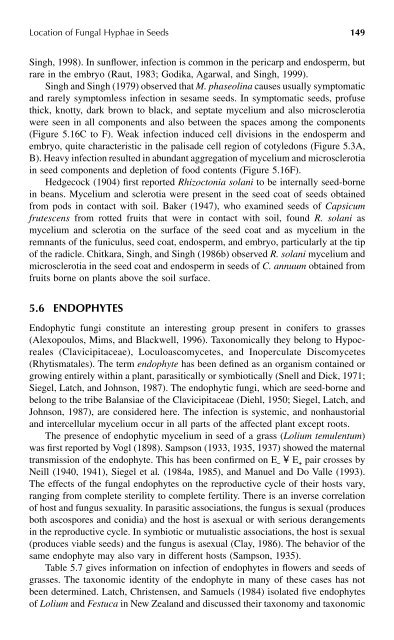Histopathology of Seed-Borne Infections - Applied Research Center ...
Histopathology of Seed-Borne Infections - Applied Research Center ...
Histopathology of Seed-Borne Infections - Applied Research Center ...
You also want an ePaper? Increase the reach of your titles
YUMPU automatically turns print PDFs into web optimized ePapers that Google loves.
Location <strong>of</strong> Fungal Hyphae in <strong>Seed</strong>s 149Singh, 1998). In sunflower, infection is common in the pericarp and endosperm, butrare in the embryo (Raut, 1983; Godika, Agarwal, and Singh, 1999).Singh and Singh (1979) observed that M. phaseolina causes usually symptomaticand rarely symptomless infection in sesame seeds. In symptomatic seeds, pr<strong>of</strong>usethick, knotty, dark brown to black, and septate mycelium and also microsclerotiawere seen in all components and also between the spaces among the components(Figure 5.16C to F). Weak infection induced cell divisions in the endosperm andembryo, quite characteristic in the palisade cell region <strong>of</strong> cotyledons (Figure 5.3A,B). Heavy infection resulted in abundant aggregation <strong>of</strong> mycelium and microsclerotiain seed components and depletion <strong>of</strong> food contents (Figure 5.16F).Hedgecock (1904) first reported Rhizoctonia solani to be internally seed-bornein beans. Mycelium and sclerotia were present in the seed coat <strong>of</strong> seeds obtainedfrom pods in contact with soil. Baker (1947), who examined seeds <strong>of</strong> Capsicumfrutescens from rotted fruits that were in contact with soil, found R. solani asmycelium and sclerotia on the surface <strong>of</strong> the seed coat and as mycelium in theremnants <strong>of</strong> the funiculus, seed coat, endosperm, and embryo, particularly at the tip<strong>of</strong> the radicle. Chitkara, Singh, and Singh (1986b) observed R. solani mycelium andmicrosclerotia in the seed coat and endosperm in seeds <strong>of</strong> C. annuum obtained fromfruits borne on plants above the soil surface.5.6 ENDOPHYTESEndophytic fungi constitute an interesting group present in conifers to grasses(Alexopoulos, Mims, and Blackwell, 1996). Taxonomically they belong to Hypocreales(Clavicipitaceae), Loculoascomycetes, and Inoperculate Discomycetes(Rhytismatales). The term endophyte has been defined as an organism contained orgrowing entirely within a plant, parasitically or symbiotically (Snell and Dick, 1971;Siegel, Latch, and Johnson, 1987). The endophytic fungi, which are seed-borne andbelong to the tribe Balansiae <strong>of</strong> the Clavicipitaceae (Diehl, 1950; Siegel, Latch, andJohnson, 1987), are considered here. The infection is systemic, and nonhaustorialand intercellular mycelium occur in all parts <strong>of</strong> the affected plant except roots.The presence <strong>of</strong> endophytic mycelium in seed <strong>of</strong> a grass (Lolium temulentum)was first reported by Vogl (1898). Sampson (1933, 1935, 1937) showed the maternaltransmission <strong>of</strong> the endophyte. This has been confirmed on E – ¥ E + pair crosses byNeill (1940, 1941), Siegel et al. (1984a, 1985), and Manuel and Do Valle (1993).The effects <strong>of</strong> the fungal endophytes on the reproductive cycle <strong>of</strong> their hosts vary,ranging from complete sterility to complete fertility. There is an inverse correlation<strong>of</strong> host and fungus sexuality. In parasitic associations, the fungus is sexual (producesboth ascospores and conidia) and the host is asexual or with serious derangementsin the reproductive cycle. In symbiotic or mutualistic associations, the host is sexual(produces viable seeds) and the fungus is asexual (Clay, 1986). The behavior <strong>of</strong> thesame endophyte may also vary in different hosts (Sampson, 1935).Table 5.7 gives information on infection <strong>of</strong> endophytes in flowers and seeds <strong>of</strong>grasses. The taxonomic identity <strong>of</strong> the endophyte in many <strong>of</strong> these cases has notbeen determined. Latch, Christensen, and Samuels (1984) isolated five endophytes<strong>of</strong> Lolium and Festuca in New Zealand and discussed their taxonomy and taxonomic


